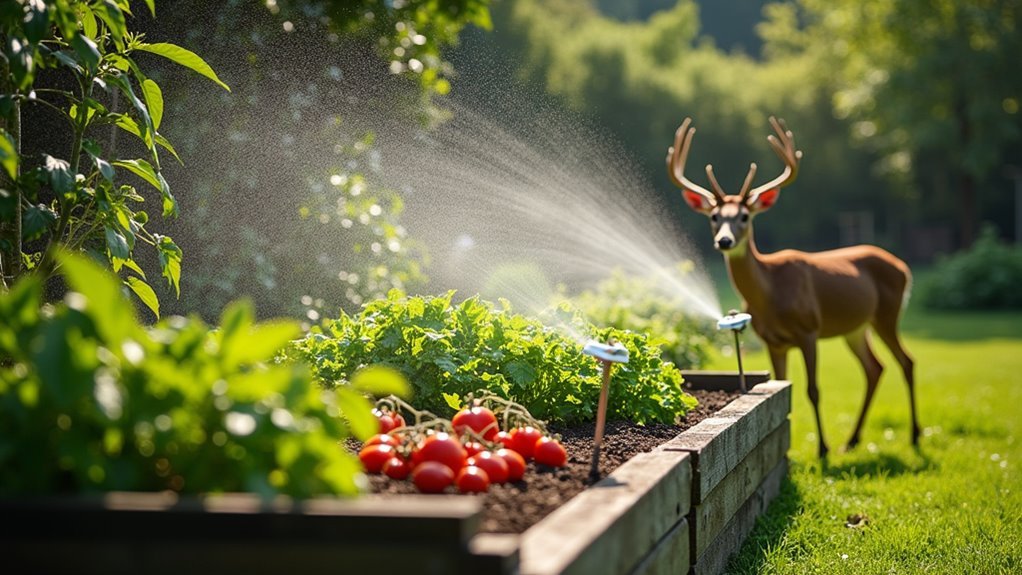You’ll need an eight-foot fence as your primary defense since deer can easily jump lower barriers. Combine this with deer-resistant plants like lavender and yarrow that naturally repel them through scent and texture. Add motion-activated sprinklers positioned 4-5 feet high at garden entry points for maximum effectiveness. Rotate your deterrent methods weekly, including visual scare tactics and sound devices, to prevent deer from adapting to your protection system. These proven strategies will transform your vulnerable garden into a fortress.
Understanding Deer Damage to Vegetable Gardens

While deer may appear graceful and harmless, they’re actually one of the most destructive pests your vegetable garden can face. These voracious creatures consume up to 10 pounds of vegetation daily, targeting your prized tomatoes, squash, and leafy greens with devastating efficiency.
Don’t let their gentle appearance fool you—deer are relentless garden destroyers that can devour 10 pounds of your vegetables daily.
Deer damage peaks during spring and early summer when they prefer tender seedlings over mature plants. Without natural predators in suburban areas, deer populations have exploded, creating unprecedented pressure on residential vegetable gardens.
A single hungry family can obliterate months of careful planning overnight, leaving behind stubble where flourishing plants once grew.
Understanding their feeding patterns helps you choose appropriate protection methods, whether installing deer fencing or applying deer repellent sprays strategically throughout your growing space.
Selecting Deer-Resistant Plants for Natural Protection
Beyond physical barriers and repellent sprays, you can harness nature’s own defense system by strategically selecting plants that deer naturally avoid.
These deer-resistant plants create natural barriers around the perimeter of your garden while adding beauty and functionality.
Choose fragrant options like lavender, sage, and catmint to establish aromatic boundaries that deter deer.
Plants with fuzzy textures, such as lamb’s ear and yarrow, also repel deer due to their unpleasant feel.
For physical protection, surround your vegetable garden with prickly varieties like globe thistle and bear’s breeches.
Berry bushes including gooseberries and currants offer dual benefits—they’re naturally avoided by deer while providing you with fresh fruit.
Implementing this permaculture approach creates layered defenses that protect your vegetables naturally.
Building the Right Height Fence for Maximum Defense

Eight feet stands as the critical minimum height for any deer fence that will truly protect your vegetable garden. This physical barrier height prevents deer from clearing your fence in a single bound, which they’re capable of doing up to eight feet.
When building your fence to keep deer away, consider these essential elements:
- Choose stockade-style fencing over see-through materials since deer hesitate to jump solid barriers.
- Install a slanted design to increase effective height and create additional climbing difficulty.
- Construct gates at the same eight-foot height with secure closing mechanisms.
- Schedule regular inspections to identify gaps or compromised sections that compromise protection.
Your fence to keep deer out requires consistent maintenance. Even small breaches can render your entire investment worthless, so stay vigilant about repairs.
Welded Wire vs. Electric Fencing Options
Once you’ve determined your fence height, selecting between welded wire and electric fencing becomes your next crucial decision.
Welded wire fencing delivers superior durability with its galvanized steel construction, creating an impenetrable barrier that stops garden deer and smaller pests like rabbits. You’ll enjoy years of reliable protection with minimal maintenance requirements.
Galvanized steel welded wire creates an impenetrable barrier against deer and rabbits with minimal maintenance for years of reliable garden protection.
Electric fencing offers flexibility and easier installation, delivering mild shocks that train deer to avoid your garden. However, you’ll need regular maintenance and must comply with local safety regulations, especially around children and pets.
Both options require 8-foot heights to prevent deer from jumping over your barrier.
While welded wire demands more labor-intensive installation with secure anchoring, electric systems allow seasonal setup and removal, giving you adaptable garden protection.
Strategic Placement of Motion-Activated Deterrents

You’ll maximize your motion-activated deterrents’ effectiveness by identifying ideal placement zones where deer typically enter your garden.
Your devices must provide adequate sensor range coverage to detect movement across all vulnerable areas without creating blind spots.
You’ll need to adjust timing and sensitivity settings to trigger responses for deer-sized animals while avoiding false alarms from smaller wildlife or wind-blown debris.
Optimal Placement Zones
Strategic placement of motion-activated deterrents can make the difference between a thriving vegetable garden and one that becomes a deer buffet. Unlike traditional deer fences, these devices offer flexible coverage that can keep the deer away from your most vulnerable crops.
To maximize effectiveness around your garden, focus on these ideal placement zones:
- Entry points and pathways – Position devices where deer typically enter your property.
- Garden perimeter corners – Create overlapping coverage zones for thorough protection.
- High-value crop areas – Protect your most attractive vegetables with concentrated deterrence.
- Natural corridors – Block deer travel routes between wooded areas and your garden.
Set sensors 4-5 feet high for proper deer detection. Regularly relocate devices to maintain surprise effectiveness, preventing deer from adapting to fixed patterns.
Sensor Range Coverage
Understanding sensor range is essential for creating an effective barrier system that catches deer before they reach your prized tomatoes and lettuce. Most motion-activated deterrents work effectively within a 20 to 40-foot range, giving you substantial coverage area for detecting approaching wildlife.
Position your deterrents strategically to face primary deer approaches, ensuring no fence posts or dense vegetation block the sensors. You’ll want to avoid obstructions that create blind spots where deer can slip through undetected.
For larger gardens, install multiple devices with overlapping coverage zones. This prevents deer from finding uncovered entry points regardless of their approach direction.
Remember to regularly monitor and adjust placement as deer adapt their routes and your garden layout changes throughout growing seasons.
Timing and Sensitivity
Beyond proper sensor placement, fine-tuning your motion detectors’ sensitivity settings can make the difference between catching every deer and missing the cautious ones that move slowly through your garden.
Adjust your sensitivity to the highest setting to detect even the slightest movement from smaller or hesitant deer. While deer netting provides physical barriers, motion-activated deterrents add an element of surprise that’s vital for protection.
- Set detectors to trigger with minimal movement to catch cautious deer before they reach plants
- Position devices along garden perimeters to create overlapping zones of coverage
- Test sensitivity levels regularly by walking through detection areas at varying speeds
- Combine motion-activated deterrents with other barrier methods for thorough protection
This fine-tuning guarantees your system responds effectively to all deer behavior patterns, maximizing your garden’s defense.
Applying Scent-Based Repellents Effectively
When deer consistently raid your vegetable garden, scent-based repellents offer an immediate and flexible defense strategy.
These gardening tips focus on creating odors unpleasant to deer through garlic or egg-based products. Apply repellents weekly to maintain effectiveness and prevent deer from adapting to familiar scents.
Choose products with spreader-sticker additives to enhance adhesion and extend scent duration on plant surfaces. Target non-deer-resistant plants, especially during winter when deer become more desperate for food sources.
Experiment with homemade mixtures by blending water with garlic powder and cayenne pepper for a potent, cost-effective deterrent. Spray this solution directly on vulnerable plants.
Setting weekly reminders guarantees consistent application, which is vital for maintaining the repellent’s protective barrier against persistent deer intrusion in your vegetable garden.
Creating Physical Barriers With Landscape Design
While scent-based repellents provide temporary protection, physical landscape barriers create lasting deterrents that deer can’t simply overcome through persistence.
Strategic landscape design transforms your garden into a natural fortress. Start by establishing your fence line with irregularly shaped rocks or dense shrubs that create intimidating barriers deer won’t cross.
Transform your garden perimeter into an impenetrable natural fortress using strategically placed rocks and dense shrubs as permanent deer barriers.
Consider implementing a double fence layer to create an enclosed space that further discourages entry.
Key physical deterrents include:
- Elevated growing: Use raised beds and containers to make plants harder to reach
- Strategic plant choices: Place prickly or heavily scented plants around your garden perimeter
- Movement obstacles: Stack firewood or position garden ornaments to disrupt deer paths
- Natural barriers: Incorporate dense shrubs and irregular rocks along vulnerable areas
This thorough approach creates multiple deterrent layers without relying on temporary solutions.
Using Sound and Visual Scare Tactics
Although physical barriers provide excellent long-term protection, sound and visual scare tactics offer an immediate and dynamic defense system that keeps deer constantly unsettled.
Motion-activated sprinklers and noise-making devices deliver unexpected bursts that effectively deter approaching deer through startling encounters. You can hang wind chimes or old CDs around your garden to create dual sound and visual disruption, using reflective surfaces to confuse and scare them away.
Simple burglar alarms made from tin cans strung together alert you while producing frightening noise.
Regularly rearrange your deterrents since deer remain naturally cautious of novel objects. Incorporate shiny aluminum pie tins or metallic streamers to leverage visual stimuli that create an unsettling atmosphere, discouraging deer from entering your vegetable garden through constant environmental uncertainty.
Rotating Multiple Deterrent Methods
Since deer adapt quickly to consistent deterrent patterns, you must rotate multiple deterrent methods regularly to maintain an effective defense system.
This strategic approach keeps deer uncertain about your garden’s defenses, preventing them from developing confidence around specific barriers.
Your rotating strategy should include:
- Combining scent repellents, motion devices, and physical barriers to create unpredictable challenges
- Moving deterrent placements weekly – relocate wind chimes, reflective tape, and decorative items
- Observing deer behavior patterns to identify which methods work best in your specific area
- Connecting with local gardening communities for region-specific advice on effective rotation schedules
Maintaining Your Deer Barrier System Year-Round
Your deer barrier system requires consistent maintenance throughout all four seasons to remain effective against persistent wildlife intrusion.
You should regularly inspect your fencing for damage, wear, or gaps that could allow deer from entering your garden. Pay special attention after storms or harsh weather conditions that might compromise structural integrity.
Keep vegetation trimmed around the perimeter to prevent deer from using overgrowth as cover or climbing assistance.
Monitor deer activity patterns seasonally, as their behavior changes with food availability and breeding cycles.
Verify all gates and access points remain securely latched and functional.
Clean debris from fence lines periodically and consider annual upgrades using improved materials or techniques.
This proactive approach maintains your barrier’s effectiveness while adapting to evolving deer pressures in your area.
Frequently Asked Questions
What Is the Best Deer Deterrent for Vegetable Garden?
You’ll find an 8-foot tall fence is your most effective deer deterrent. Combine it with motion-activated sprinklers, strongly scented plants like lavender, and regular scent-based repellent applications for maximum protection.
What Smell Do Deer Absolutely Hate?
Deer absolutely hate strong, pungent smells like garlic, onion, peppermint, and citronella. You’ll find they’re also repelled by predator scents from bloodmeal or putrescent eggs, which trigger their natural fear responses.
What Is the Best Fencing to Keep Deer Out of Your Garden?
You’ll need an eight-foot-tall stockade fence for maximum effectiveness. Welded wire fences work well too, especially if you’re dealing with smaller pests like rabbits alongside deer in your garden area.
What Will Deer Not Jump Over?
Deer won’t jump over solid fences that’re 8 feet tall or higher. They’ll also avoid slanted barriers, dense thorny shrubs, or electric fences since these obstacles appear too challenging or risky for them to clear safely.
In Summary
You’ll protect your vegetable garden from deer damage by combining multiple strategies. Don’t rely on just one method—rotate between physical barriers, deterrents, and resistant plants for best results. You’ll need to maintain your system consistently, adjusting heights and replacing worn materials. Remember that deer adapt quickly, so you’ll want to switch up your tactics regularly. With persistence and the right combination of barriers, you’ll keep your harvest safe from hungry deer year-round.





Leave a Reply